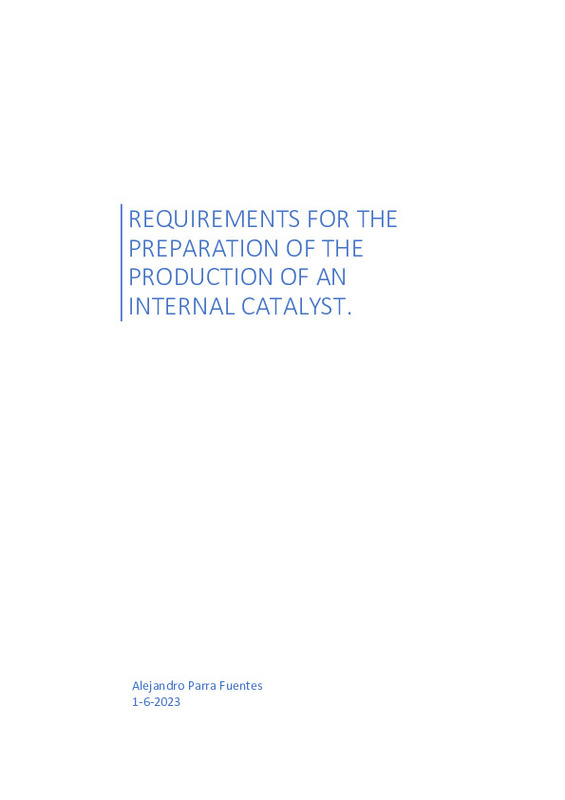JavaScript is disabled for your browser. Some features of this site may not work without it.
Buscar en RiuNet
Listar
Mi cuenta
Estadísticas
Ayuda RiuNet
Admin. UPV
Requirements for the preparation of the production of an internal catalyst
Mostrar el registro sencillo del ítem
Ficheros en el ítem
| dc.contributor.advisor | Suárez Ruz, María Esperanza
|
es_ES |
| dc.contributor.author | Parra Fuentes, Alejandro
|
es_ES |
| dc.date.accessioned | 2023-11-02T12:40:46Z | |
| dc.date.available | 2023-11-02T12:40:46Z | |
| dc.date.created | 2023-09-26 | |
| dc.date.issued | 2023-11-02 | es_ES |
| dc.identifier.uri | http://hdl.handle.net/10251/199131 | |
| dc.description.abstract | [ES] El presente trabajo de fin de máster persigue el objetivo de analizar la viabilidad de la implantación y comercialización de un catalizador interno. El catalizador en el cilindro es un método adicional, colocando el componente en la cámara de combustión, mucho más cerca del proceso de combustión, que permite reducir las emisiones de gases como monóxido de carbono, hidrocarburos... en la propia fuente de emisión (el catalizador se aplica en las bujías de incandescencia). Estas soluciones son necesarias porque la reducción de las emisiones de escape de los vehículos es un aspecto clave para reducir el impacto negativo del transporte en el medio ambiente. La aplicación de este método se conoce como método complementario de postratamiento de los gases de escape. En la actualidad, existen numerosas investigaciones científicas que analizan la eficacia de este sistema en condiciones estacionarias, y los estudios de estados dinámicos, en los que se basa esta tesis, fueron realizados por la tutora de este proyecto (Monika Andrych-Zalewska, DEng. - Facultad de Ingeniería Mecánica, Universidad Tecnológica de Wrocław), siendo miembro de un equipo de investigación, realizando una prueba de emisiones en conducción real. Durante el desarrollo del proyecto se van a abordar los siguientes temas: descripción, preparación y riesgos relacionados con la aplicación práctica/potencial implantación; falta de barreras en la implantación y comercialización; y los beneficios de la implantación del sistema. La principal motivación para llevar a cabo estos estudios sobre la aplicación de este concepto es que podría ayudar a hacer frente a la huella de carbono, asegurando el compromiso con los objetivos de la Agenda 2030, y ayudar a construir un futuro sostenible para las próximas generaciones. | es_ES |
| dc.description.abstract | [EN] The current master¿s degree thesis follows the goal of analysing the viability of the implementation and commercialization of an internal catalyst. The in-cylinder catalyst is an additional method, placing the component in the combustion chamber, much closer to the combustion process, which allows to reduce the emissions of gases such as carbon monoxide, hydrocarbons¿ at the very source of emission (the catalyst is applied on the glow plugs). These solutions are necessary because the reduction of exhaust emissions from vehicles is a key aspect of reducing the negative impact of transport in the environment. The application of this method is known as a supplementary method of exhaust gas aftertreatment. Currently, there are numerous scientific investigations analysing the efficiency of this system in stationary conditions, and the dynamic states studies, in which this thesis is based on, were carried out by the tutor of these project (Monika Andrych-Zalewska, DEng. ¿ Faculty of Mechanical Engineering, Wrocław University of Technology), being a member of an investigation team, conducting a real driving emission test. During the development of the project the following topics are going to be addressed: description, preparation and risks related to practical application/potential implementation; lack of barriers in the implementation and commercialization; and the benefits of the implementation of the system. The main motivation for undertaking these studies about the application of this concept is that it could help to deal with the carbon footprint, ensuring commitment to the 2030 Agenda objectives, and to help to build a sustainable future for next generations. | es_ES |
| dc.format.extent | 34 | es_ES |
| dc.language | Inglés | es_ES |
| dc.publisher | Universitat Politècnica de València | es_ES |
| dc.rights | Reserva de todos los derechos | es_ES |
| dc.subject | Catalizador interno | es_ES |
| dc.subject | Catalizador en el cilindro | es_ES |
| dc.subject | Postratamiento de gases de escape | es_ES |
| dc.subject | Huella de carbono | es_ES |
| dc.subject | Prueba de emisiones en conducción real. | es_ES |
| dc.subject | Internal catalyst | es_ES |
| dc.subject | In-cylinder catalyst | es_ES |
| dc.subject | Exhaust after-treatment | es_ES |
| dc.subject | Carbon footprint | es_ES |
| dc.subject | Real driving emissions test. | es_ES |
| dc.subject.classification | ORGANIZACION DE EMPRESAS | es_ES |
| dc.subject.other | Máster Universitario en Ingeniería Industrial-Màster Universitari en Enginyeria Industrial | es_ES |
| dc.title | Requirements for the preparation of the production of an internal catalyst | es_ES |
| dc.title.alternative | Requisitos para la preparación de la producción de un catalizador interno | es_ES |
| dc.title.alternative | Requisits per a la preparació de la producció d'un catalitzador intern | es_ES |
| dc.type | Tesis de máster | es_ES |
| dc.rights.accessRights | Abierto | es_ES |
| dc.contributor.affiliation | Universitat Politècnica de València. Departamento de Organización de Empresas - Departament d'Organització d'Empreses | es_ES |
| dc.contributor.affiliation | Universitat Politècnica de València. Escuela Técnica Superior de Ingenieros Industriales - Escola Tècnica Superior d'Enginyers Industrials | es_ES |
| dc.description.bibliographicCitation | Parra Fuentes, A. (2023). Requirements for the preparation of the production of an internal catalyst. Universitat Politècnica de València. http://hdl.handle.net/10251/199131 | es_ES |
| dc.description.accrualMethod | TFGM | es_ES |
| dc.relation.pasarela | TFGM\155610 | es_ES |
Este ítem aparece en la(s) siguiente(s) colección(ones)
-
ETSII - Trabajos académicos [10404]
Escuela Técnica Superior de Ingenieros Industriales






